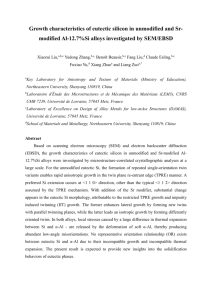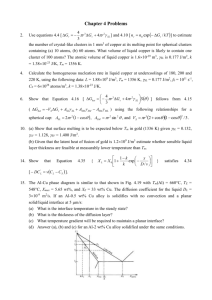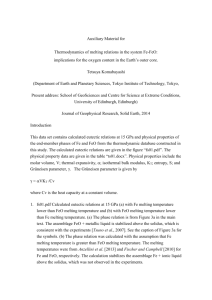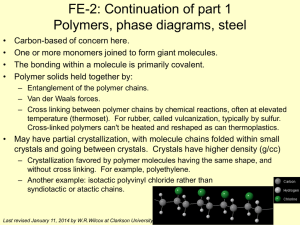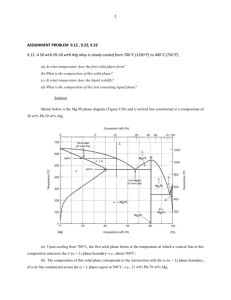Lecture W4-L1
advertisement
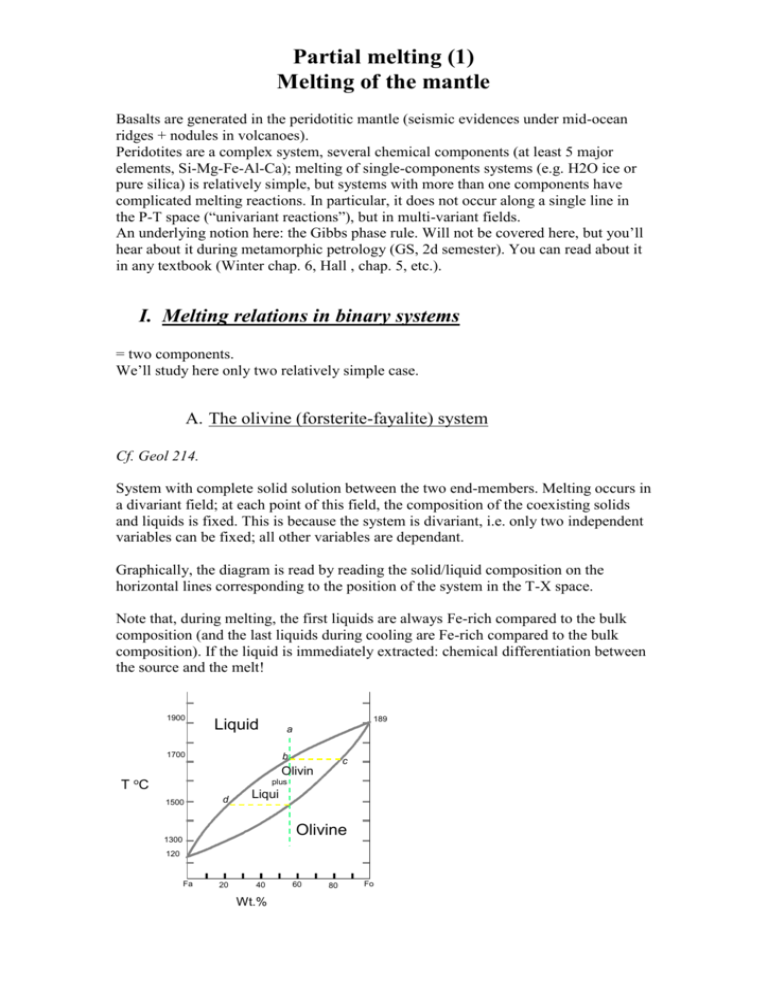
Partial melting (1) Melting of the mantle Basalts are generated in the peridotitic mantle (seismic evidences under mid-ocean ridges + nodules in volcanoes). Peridotites are a complex system, several chemical components (at least 5 major elements, Si-Mg-Fe-Al-Ca); melting of single-components systems (e.g. H2O ice or pure silica) is relatively simple, but systems with more than one components have complicated melting reactions. In particular, it does not occur along a single line in the P-T space (“univariant reactions”), but in multi-variant fields. An underlying notion here: the Gibbs phase rule. Will not be covered here, but you’ll hear about it during metamorphic petrology (GS, 2d semester). You can read about it in any textbook (Winter chap. 6, Hall , chap. 5, etc.). I. Melting relations in binary systems = two components. We’ll study here only two relatively simple case. A. The olivine (forsterite-fayalite) system Cf. Geol 214. System with complete solid solution between the two end-members. Melting occurs in a divariant field; at each point of this field, the composition of the coexisting solids and liquids is fixed. This is because the system is divariant, i.e. only two independent variables can be fixed; all other variables are dependant. Graphically, the diagram is read by reading the solid/liquid composition on the horizontal lines corresponding to the position of the system in the T-X space. Note that, during melting, the first liquids are always Fe-rich compared to the bulk composition (and the last liquids during cooling are Fe-rich compared to the bulk composition). If the liquid is immediately extracted: chemical differentiation between the source and the melt! 1900 Liquid 1700 b T oC 1500 189 0 a d c Olivin plus e Liqui d Olivine 1300 120 5 Fa 20 40 Wt.% Forsterite 60 80 Fo B. The diopside-anorthite system Not a bad equivalent of a basalt. No solid solution here, but a specific point called eutectic. Melting works more or less as above, but (graphically) the horizontal lower line (solidus) implies that the first liquid always is on the eutectic! This is an important observation: whatever the composition of a system (that can be expressed as An+Di), the first (or last) melts will always be of eutectic composition, about 40% An and 60% Di. The melting reaction that occurs here are (for a system e.g. left of the eutectic): - 40 An + 60 Di = 100 L; this reaction occurs at 1274° and operates until one of the reactant (in this example, An) is exhausted. At that stage, the remaining solid is pure Di (all the An is consumed) and the melt is obviously An40Di60. - L1 + Di = L2; this reaction occurs with increasing temperature, and corresponds to the progressive dissolution of the remaining Di into the melt. Unlike the previous one, it operates over a range of temperatures (1274 to whatever T corresponds to the liquidus of this bulk composition). 1600 Liquid Liquidus 1553 1500 T oC 1400 Anorthite + Liquid 1392 1300 Diopside + Liquid 1274 1200 Diopside + Anorthite Di 20 40 60 80 An Wt.% Anorthite II. Three-components systems: the An-di-Fo system A relatively good analogue of the mantle. It’s a generalization of the An-Di studied above; each of the binary subsystems has an eutectic. Representation: 3D (2D for the composition space and one for T), or projection on the composition plan with “contour lines” corresponding to the temperatures. The eutectic is at An43Fo10Di47; it is an eutectic, so first liquids always have this composition whatever the starting material. A. Melting of a mantle-like composition Mantle composition will be close to the Fo apex, and with Di > An. - - - Melting starts at 1270° (eutectic temperature), by the reaction 43 An + 10 Fo + 47 Di = 100 L. The melting proceeds until one of the reactants is exhausted (An, probably). The remaining solid is therefore Ol+Di. Graphically, the liquid is at M, and the solids move from the bulk composition, towards the Di-Fo side. It is an eutectic reaction, so it operates at a constant T (univariant reaction). Once An is exhausted, the reaction becomes L1 + Di + Fo = L2. Again, this proceeds until Di is exhausted in turn. Graphically, this corresponds to the liquids “creeping” along the “valley” Di-Fo, and the solids moving along the Di-Fo side until all Di is consumed (=until the solid composition reaches the Fo corner). This is a divariant reaction and operates over a range of T (1270 to 1350° in this example). Di is now entirely consumed. The only possible reaction becomes L2 + Fo = L3. This obviously causes the liquid composition to now move straight towards the Fo corner (the solid remains Fo only and has no reason to move anymore). This continues until Fo is exhausted in turn (i.e, until all the system becomes liquid); graphically, it happens when the liquid composition has crept along the slope up to the bulk composition position. This divariant reaction again operates over a range of T (from 1350 to 1750° here). Can you write the same story for a different bulk composition ? B. Some points of interest - - The eutectic is at An43Fo10Di47; the first liquids always have this composition, whatever the bulk composition of the source. You can work out the wt% proportion of this composition: it is relatively similar to a basalt. Which is obvious from the mineralogy anyway (plag + cpx). The eutectic is at 1270°, which is therefore the melting point of the mantle; - - It is also the liquidus, AND the solidus of a basalt of eutectic composition (both being at the same temperature for a liquid of eutectic composition). If the liquid is not absolutely eutectic, the solidus and liquidus differ (but this still gives a reasonable order of magnitude of a basalt’s solidus/liquidus). This diagram can also be read to discuss what is liquid at a given temperature (by “filling the valley”). It shows that liquids composition stay close to the eutectic, differing from this composition only as T significantly increases. Therefore, all melts of a normal mantle can be expected to be more or less basaltic! III. Effects of other parameters A. Pressure Pressure moves both the position and the temperature of the eutectic (ex: An-Di binary): - In this system, higher P means higher eutectic T, the solidus has a positive slope (for the thermodynamics-inclined reader: the An+Di=L reaction has a positive Clapeyron slope). - Higher P also shifts the eutectic towards the An-rich side. Same effects can be observed in ternary diagrams. An interesting example: Fo-NeSiO2 (…which again differentiates between Ne-normative, Ol-normative and qznormative rocks!!). In this diagram, increasing P shifts the eutectic towards the Ne apex, into the strongly undersaturated field. B. Fluids Fluids typically strongly depress the solidus (by allowing reactions such as minerals + H2O = L, which operate at far lower temperatures, owing to the strongly incompatible characteristic of water). They also move the eutectic position; and different fluids can move it in different directions (cf. H2O vs. CO2). IV. Complex systems A. Phase relations Systems with more than 3 components can not be easily graphically represented. Need to use empirical or semi-empirical approaches (more in the next lecture)… and to use graphical projections, commonly P-T. Can you write the melting reactions from the coexisting assemblages? Note that the present mineral phases (and, therefore, the melting reactions!) are dependant of the pressure. This should not be a surprise, as we’ve just seen that the eutectic’s position is displaced by increasing P! B. Controls on melt composition From the above diagrams, it is clear that the eutectic and the melting reactions are a function of P (and T). Therefore, the liquids composition will evolve both with P and T; they will remain broadly basaltic but with some differences. In general, more undersaturated rocks are generated at higher temperature (progressive incorporation of the mafic components, Fo and Di in the ternary An-DiFo, in the melt) and higher pressure (eutectic shifted towards undersaturated compositions).
